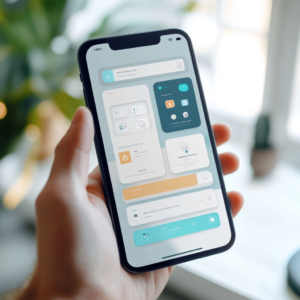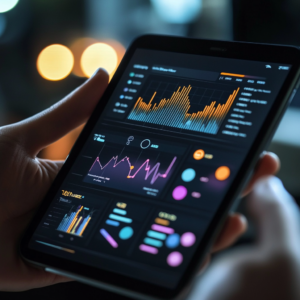1. Introduction
In today’s fast-paced digital world, mobile learning has emerged as a transformative force in education. This article, titled The Impact of Mobile Learning: Trends and Opportunities, provides a comprehensive, step-by-step guide to understanding how mobile devices are reshaping the educational landscape. Mobile learning is not simply about accessing courses on a smartphone—it is a revolutionary approach that offers unprecedented flexibility, accessibility, and personalized learning experiences. Our focus throughout this article is on The Impact of Mobile on modern education. In this guide, you will learn about emerging trends, the benefits and challenges of mobile learning, and the technological innovations driving this paradigm shift. For additional insights into digital learning strategies, click here to read “The Ultimate Guide to eLearning Success: Tips and Tools”.

2. Evolution and Trends in Mobile Learning
Over the past decade, mobile learning has evolved from simple text-based lessons on basic devices to fully interactive, multimedia-rich experiences available on smartphones and tablets. The transition from 2G to 4G—and now 5G—has enabled high-definition streaming, real-time interaction, and immersive learning environments, all of which clearly demonstrate The Impact of Mobile on education. For official global statistics and trends, consider visiting the UNESCO Institute for Statistics.

3. Benefits of Mobile Learning
Mobile learning offers numerous benefits that contribute to its growing popularity among learners and educators alike. One major advantage is the unparalleled accessibility it provides; learners can access educational content anytime, anywhere—whether they are commuting, traveling, or away from a traditional classroom. This flexibility empowers students to pursue education on their own schedules, which is a key aspect of The Impact of Mobile. Additionally, mobile platforms enable personalized learning by leveraging data analytics and AI to tailor experiences to individual needs. Interactive elements, such as quizzes and simulations, further boost engagement, making mobile learning a powerful tool for improving academic outcomes.
4. Challenges and Opportunities in Mobile Learning
Mobile learning, despite its transformative benefits, presents a unique set of challenges that educators and developers must address. At the same time, these challenges create opportunities for innovation, improved design, and enhanced learner engagement. This section is divided into several sub-sections that explore these challenges and the opportunities they present.
4.1 Device Compatibility and Performance Issues
One of the most significant challenges in mobile learning is ensuring that content is accessible and performs well across a diverse range of devices. Smartphones and tablets vary widely in terms of screen size, operating systems, processing power, and resolution. This diversity means that educational content must be carefully optimized to function seamlessly on all platforms. Poorly optimized content can lead to slow loading times, distorted images, and a frustrating user experience. However, this challenge also opens the door to innovation in responsive design and adaptive technologies. By investing in rigorous testing and utilizing modern design frameworks, developers can create courses that adjust dynamically to any device, thereby enhancing The Impact of Mobile on the learning experience.
4.2 Managing Distractions and Maintaining Focus
Mobile devices are inherently multifunctional, serving not only as learning tools but also as gateways to social media, games, and other non-educational applications. This multiplicity can lead to distractions that reduce the effectiveness of learning. Educators face the challenge of capturing and maintaining the learner’s attention amid these competing interests. On the flip side, this scenario presents an opportunity to design highly engaging, interactive content that competes effectively with other mobile applications. By integrating gamification elements, interactive quizzes, and real-time feedback, educators can help learners stay focused and actively engaged. This dual approach not only mitigates distractions but also leverages them to enhance The Impact of Mobile in delivering captivating learning experiences.
4.3 Connectivity and Infrastructure Challenges
Reliable internet connectivity is crucial for a seamless mobile learning experience. In many parts of the world, especially in remote or underdeveloped regions, inconsistent or slow internet connections can significantly hinder the delivery of digital content. Connectivity issues may result in buffering during video streaming, interrupted interactive sessions, and overall reduced accessibility to learning materials. Nevertheless, these challenges encourage continuous improvements in network infrastructure and the development of offline learning capabilities. For example, many platforms now allow users to download course materials for offline study, ensuring that learning continues uninterrupted. Such advancements not only address connectivity issues but also amplify The Impact of Mobile by ensuring that quality education is accessible regardless of geographical limitations.
4.4 Content Design and User Experience
Creating engaging content for mobile learning is both an art and a science. One challenge is adapting traditional educational materials to formats that are effective on small screens. Text-heavy documents and static images may not translate well to mobile devices, necessitating a complete rethink of content delivery. This challenge offers an opportunity to embrace innovative design techniques that prioritize simplicity, clarity, and interactivity. By employing modern UI/UX principles, educators can design visually appealing, intuitive, and easy-to-navigate courses that maximize the user experience. Improved content design not only enhances learning outcomes but also reinforces The Impact of Mobile by making education more accessible and enjoyable.
4.5 Opportunities for Innovation and Growth
Every challenge in mobile learning presents a corresponding opportunity for innovation. The issues of device compatibility, distraction management, connectivity, and content design push developers and educators to explore new technologies and creative solutions. For example, the rapid advancement of 5G technology promises to eliminate many connectivity issues, while augmented reality (AR) and virtual reality (VR) are set to offer immersive learning experiences that were previously unimaginable. Additionally, data analytics and AI-driven personalization are transforming how courses are tailored to individual learners, providing deeper insights and more effective educational interventions. These opportunities not only address the inherent challenges but also pave the way for a future where The Impact of Mobile is even more pronounced, leading to more inclusive and engaging learning environments.
5. Technological Advances Driving Mobile Learning
Technological innovation is at the core of mobile learning’s evolution. The advent of 5G connectivity has dramatically improved streaming speeds and reduced latency, enabling real-time interactions and high-definition content delivery that exemplify The Impact of Mobile. Modern mobile devices feature advanced processors and high-resolution displays, supporting rich multimedia experiences. Artificial intelligence and machine learning now facilitate adaptive, personalized learning, while emerging augmented reality (AR) and virtual reality (VR) technologies offer immersive, hands-on experiences that further transform education.
6. Strategies for Effective Mobile Learning Implementation
To fully harness mobile learning, educators must adopt strategies that address both opportunities and challenges.
6.1 Designing Responsive and Adaptive Content
Creating content that adapts seamlessly to various mobile devices is essential. Utilize responsive design principles and test your courses on multiple devices to ensure a smooth user experience. A well-optimized mobile course improves engagement and underscores The Impact of Mobile by delivering a consistent and accessible learning experience.
6.2 Enhancing Interactivity and Engagement
Integrate interactive elements such as quizzes, polls, and discussion forums to keep learners actively involved. Gamification techniques—like awarding badges, displaying leaderboards, and offering rewards—motivate learners and transform passive content consumption into an engaging, hands-on experience, reinforcing The Impact of Mobile.
6.3 Utilizing Data Analytics for Continuous Improvement
Leverage analytics tools to monitor learner behavior and course performance. Regularly review key metrics such as engagement rates, completion rates, and feedback scores. These insights allow for continuous refinement of your content and teaching methods, ensuring that The Impact of Mobile remains effective and evolves with learner needs.
6.4 Providing Robust Technical Support
Ensure that learners have access to reliable technical support through comprehensive help guides, live chat, and troubleshooting resources. A strong support system minimizes disruptions and further reinforces The Impact of Mobile by making technology a true enabler of learning.
6.5 Fostering Collaborative Learning Environments
Encourage collaboration among learners by incorporating social learning tools such as discussion boards, group projects, and live webinars. A collaborative learning environment not only enhances engagement but also highlights The Impact of Mobile by facilitating shared, interactive experiences.
7. Case Studies and Real-World Examples
Numerous institutions have successfully integrated mobile learning into their educational models. For instance, a leading university adopted a mobile-first strategy that allowed students to access course materials, participate in live discussions, and submit assignments via a dedicated mobile app. This initiative led to a significant increase in student engagement and satisfaction, clearly demonstrating The Impact of Mobile on academic success. Similarly, a global corporation implemented mobile training modules for employee development, resulting in improved knowledge retention and accelerated skill acquisition. These examples underscore how mobile learning can transform educational outcomes across different contexts.
8. Additional Insights and Global Perspectives
Beyond the immediate benefits, mobile learning holds vast implications for global education. Its inherent accessibility helps bridge educational gaps, enabling learners in remote or underserved regions to access high-quality resources. For example, projects supported by the World Bank have shown how mobile learning initiatives can uplift communities by providing critical educational access. Mobile learning also fosters continuous professional development; educators worldwide are now able to participate in online training, virtual conferences, and collaborative workshops, thereby reinforcing The Impact of Mobile on lifelong learning. Additionally, mobile learning drives workforce development by equipping employees with the skills they need to thrive in a digital economy. Global educational leaders and policymakers are increasingly focusing on mobile learning as a tool to democratize education and promote inclusive growth, further validating The Impact of Mobile on a global scale.

9. Recommendations for Educators and Policymakers
To fully capitalize on the opportunities presented by mobile learning, educators and policymakers must work together to foster an environment conducive to innovation and accessibility.
9.1 For Educators
Educators should prioritize the development of mobile-friendly content that is interactive and engaging. Emphasize multimedia elements and real-time feedback to keep learners motivated. Incorporate continuous professional development to stay updated with emerging technologies and pedagogical strategies. Educators are encouraged to adopt flexible teaching methods that accommodate the mobile learning paradigm, thereby maximizing The Impact of Mobile on student outcomes.
9.2 For Policymakers
Policymakers need to invest in infrastructure that supports high-speed internet access across all regions. Encourage educational institutions to integrate mobile learning into their curricula through grants and subsidies. Establish standards and best practices for mobile learning to ensure quality and accessibility. By creating policies that support digital education, governments can enhance The Impact of Mobile on national education systems and drive socioeconomic development.
9.3 Collaborative Initiatives
Both educators and policymakers should foster partnerships with technology providers to develop innovative mobile learning solutions. Collaborative initiatives can lead to the creation of cutting-edge tools and resources that further enhance the learning experience. Such partnerships exemplify The Impact of Mobile by merging expertise from different sectors to create a more dynamic educational environment.
10. Future Trends and Predictions
The future of mobile learning is full of promise and innovation. One major trend is the expansion of AI-driven personalization, where advanced algorithms will tailor learning experiences to individual needs with remarkable precision. Immersive technologies like AR and VR are set to offer hands-on, interactive experiences that simulate real-world environments, providing a new dimension to learning. The global rollout of 5G networks will further enhance connectivity, breaking down geographical barriers and ensuring that The Impact of Mobile is experienced universally. Additionally, the integration of mobile learning with other digital platforms will enable more cohesive and adaptive learning ecosystems, ensuring continuous improvement and innovation.
For a deeper dive into these emerging trends, I recommend watching this YouTube video on the future of online course tools from a leading educational technology channel. This video provides valuable insights into how cutting-edge technologies are shaping the future of mobile learning.
Unlock Exclusive Affiliate Offers
If you are interested in expanding your knowledge, I recommend this course, which was productive for me and helped me to reach new study topics about communication. To maximize your eLearning success, explore our unique product that offers a complete toolkit to plan and organize your studies and your time.
11. Conclusion
Mobile learning is reshaping education by offering unparalleled flexibility, personalized experiences, and interactive content. This comprehensive guide on The Impact of Mobile Learning: Trends and Opportunities has explored the evolution, benefits, challenges, and technological advances driving mobile learning. Embracing these trends and opportunities allows educators and institutions to create dynamic, accessible, and engaging learning experiences. Ultimately, understanding and leveraging The Impact of Mobile is essential for transforming education and ensuring long-term success in a digital world. As technology continues to evolve, the potential for innovation in mobile learning will only expand, paving the way for a more connected and inclusive future.
Before wrapping up, it is important to remember that as technology evolves, so do the opportunities for innovative educational strategies. Staying informed and adaptable will ensure that your educational approaches remain effective and forward-thinking.
12. Frequently Asked Questions (FAQ)
Q1: What is mobile learning?
A1: Mobile learning refers to educational content and experiences delivered via mobile devices, offering flexibility and accessibility for learners.
Q2: What are the key benefits of mobile learning?
A2: Benefits include increased accessibility, personalized learning experiences, interactive content, and the convenience of learning on-the-go.
Q3: What challenges does mobile learning face?
A3: Challenges include ensuring device compatibility, managing distractions, and designing responsive content—challenges that also drive innovation.
Q4: How do technological advances enhance mobile learning?
A4: Innovations such as 5G, AI-driven personalization, and AR/VR immersive experiences significantly enhance mobile learning, reinforcing The Impact of Mobile on education.
Q5: What future trends are expected in mobile learning?
A5: Future trends include deeper AI integration, expanded AR/VR applications, improved connectivity, and more integrated learning platforms.
Thank you for reading this comprehensive guide on The Impact of Mobile Learning: Trends and Opportunities. I hope the insights, trends, and strategies provided here empower you to harness the power of mobile learning and seize the opportunities it presents for transforming education. If you have any questions or need further adjustments, please let me know!
